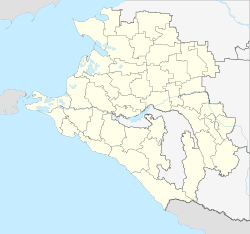Tbilisskaya
| Staniza
Tbilisskaya
Tbilisi
|
||||||||||||||||||||||||||||||||||||
|
||||||||||||||||||||||||||||||||||||
|
||||||||||||||||||||||||||||||||||||
| List of large settlements in Russia | ||||||||||||||||||||||||||||||||||||
Tbilisskaya ( Russian Тбилисская ) is a Staniza in the Krasnodar region ( Russia ) with 25 317 inhabitants (14 October 2010).
geography
Stanitsa is located in the northern foothills of the Greater Caucasus , about 100 kilometers as the crow flies northeast of the regional administrative center of Krasnodar , on the right bank of the Kuban River .
Tbilisskaya is the administrative center of the Tbilisskaya Rajon of the same name . In addition to Stanitsa, the rural community of Tbilisskaya also includes the seven smaller settlements Gorski, Mirny, Oktyabrski, Pervomaiski, Severin, Ternowy and Vostochny, which are located in the area on both sides of the river.
history
The stanitsa goes back to a redoubt in which a regiment of the Imperial Russian Army was stationed between 1788 and 1791 in the summer months , which was deployed in the conquest of the Caucasus. It was named Tbilisi Regiment after the Georgian capital Tbilisi .
In 1802 a stanitsa for Cossacks was built at this point , who were resettled there from the area around Yekaterinoslav (today Dnipropetrovsk, Ukraine ). It became part of the line of fortifications along the border between the "safe" areas of the Russian Empire and the restless mountain regions, which were mostly inhabited by peoples who repeatedly rose against Russian supremacy. The Stanitsa, in which 181 families initially settled under the leadership of Jessauls Leonti Grechishkin , who was appointed ataman , was named Tiflisskaja ( i.e. Tiflisser Stanitsa ) in memory of the regiment previously stationed there . The headquarters of the First Caucasian (Cossack) Regiment was located in the Stanitsa.
Around the middle of the 19th century the strategic importance of the area ceased; the stanizi, including Tbilisi, became centers of agriculture.
As part of an administrative reform on December 31, 1934, Tbilisi became the administrative center of a newly founded Rajon. After the Russian name of the Georgian capital was changed to the Georgian one , Tbilisi , in 1936, Stanitsa and Rajon also received their current form of name Tbilisskaja (Tbilisski) .
During the Second World War , Staniza was occupied by the German Wehrmacht on August 6, 1942 during Operation Blau . On January 29, 1943, the Red Army was able to retake Tbilisskaya during the North Caucasian Operation .
Population development
| year | Residents |
|---|---|
| 1939 | 7,391 |
| 1959 | 10,229 |
| 1970 | 17,338 |
| 1979 | 18,894 |
| 1989 | 21,880 |
| 2002 | 24.134 |
| 2010 | 25,317 |
Note: census data
Culture and sights
A chapel dedicated to Andrei Grechishkin, the son of the first ataman of Stanitsa, who was killed in the fight against the Circassian rebels in 1829 , has been reconstructed in Stanitsa . Are located in the area several Kurgane from the maeotischen and Sarmatic time (1 millennium. Chr. Centuries first to n. Chr.).
Economy and Infrastructure
Tbilisskaya is the center of an agricultural area with predominantly the cultivation of cereals, sunflowers, soybeans and sugar beets as well as cattle, pig and poultry farming. There are a number of farms processing agricultural products in Staniza, including a large dairy, an oil mill and a sugar factory.
In tbilisskaya the station is located at kilometer 32 Gretschischkino (named after Andrei Gretschischkin) on the railway line from Kropotkin (Station kavkazskaya ) to Krasnodar. The single-track line operated by the North Caucasian Railway was opened in 1901 and electrified on this section in 1999 . To the north, Tbilisskaya is bypassed by the regional road R251 , which leads from Temryuk on the Taman Peninsula via Krasnodar to Kropotkin, where a good 30 kilometers east of the Stanitsa there is a connection to the M29 main road running along the northern edge of the Caucasus . Another local road between the railway line and Kuban also leads to Kropotkin; at the Staniza the river is crossed by a nearly 200 meter long road bridge.
About twelve kilometers northwest of Stanitsa there is a large transmitter ( Radiozentr Tbilisskaja ; Lage ), which broadcasts programs from several Russian radio stations in various frequency ranges from VHF to long wave , including the program of the government broadcaster Radio Chechnya Swobodnaya (Radio Free Chechnya ) on long wave.
Individual evidence
- ↑ a b Itogi Vserossijskoj perepisi naselenija 2010 goda. Tom 1. Čislennostʹ i razmeščenie naselenija (Results of the All-Russian Census 2010. Volume 1. Number and distribution of the population). Tables 5 , pp. 12-209; 11 , pp. 312–979 (download from the website of the Federal Service for State Statistics of the Russian Federation)
- ↑ History of the settlement of the area ( page no longer available , search in web archives ) Info: The link was automatically marked as defective. Please check the link according to the instructions and then remove this notice. on the Tbilisskaya Raion Library Association website (in Russian)
Web links
- Official website of the Raion Administration (Russian)



